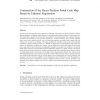Free Online Productivity Tools
i2Speak
i2Symbol
i2OCR
iTex2Img
iWeb2Print
iWeb2Shot
i2Type
iPdf2Split
iPdf2Merge
i2Bopomofo
i2Arabic
i2Style
i2Image
i2PDF
iLatex2Rtf
Sci2ools
GIS
2003
ACM
2003
ACM
Construction of the planar partition postal code map based on cadastral reGIStration
Accurate postal code maps have many applications within GIS as the postal code has the potential to link the address description of buildings to their location in a specified global reference system in a more natural way. This relationship is possible in both directions: geocoding and reverse-geocoding. These operators demand a mechanism for translating an exact geometric position (i.e., WGS84 coordinate) into a location indication (town, street, house number) and vice versa. As most built-up parcels are provided with a postal code, this indicator can be used as the linkage. This paper describes the procedure, based on the Dutch cadastral registration, to obtain a reliable 6-position (i.e., 2628BX, the highest level of detail possible) planar postal code map for the Netherlands. Problems with existing, Voronoi-diagram based, postal code maps, like intersected houses and arbitrary derived (and thus unrecognizable) boundaries are avoided. The reliability of the derived planar postal cod...
GIS | GIS 2003 | Planar Postal Code | Postal Code | Postal Code Maps |
| Added | 06 Jul 2010 |
| Updated | 06 Jul 2010 |
| Type | Conference |
| Year | 2003 |
| Where | GIS |
| Authors | Friso Penninga, Edward Verbree, Wilko Quak, Peter van Oosterom |
Comments (0)

